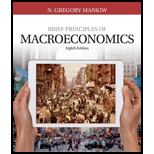
Time taken for the
Answer to Problem 1CQQ
Option ‘b’ is correct.
Explanation of Solution
Option (b):
Many studies suggest that it takes at least 6 months for the monetary policy to have an effect on aggregate demand. Monetary policy affects aggregate demand primarily by changing interest rates. However, mostly households and firms set their spending plans in advance; as a result, there is a time lag for changes in interest rate to alter the aggregate demand for goods and services Thus, option ‘b’ is correct.
Option (a):
Monetary policy works with a lag and hence, one month is insufficient for the monetary policy to reflect changes in the economy. Thus, option ‘a’ is incorrect.
Option (c):
Long lags suggest a policy that is passive rather than active, and such long gaps have an opposite effect on the economy (destabilization) as the economic conditions change from time to time. Two years is a long lag and thus, option ‘c’ is incorrect.
Option (d):
Long lags suggest a policy that is passive rather than active and such long gaps have an opposite effect on the economy (destabilization) as the economic conditions change from time to time. Five years is a really long lag and thus,option ‘d’ is incorrect.
Monetary policy: It refers to the credit
Want to see more full solutions like this?
Chapter 18 Solutions
Brief Principles of Macroeconomics (MindTap Course List)
- What role, if any, does monetary policy play in the Real Business Cycle Model?arrow_forwarda.What happens to the aggregate demand? b.What happens to the level of output? c.What happens to the price level? d.State your conclusion on the effect of the monetary policy made by the BSP.arrow_forwardHello, I need help with a macroeconomics question. Thank you in advance! The answers are based on a short exerpt from the Federal Reserves press release from Feb 1, 2023 (attatchde below). 7. What do you expect to happen to the money supply? 8. What do you expect to happen to the inflation rate? 9. How would you expect all these decisions to affect employment in the economy? 10. How do the effects you found on 8 and 9 align with what the Fed was hoping to attain?arrow_forward
- b. How do fiscal and monetary policies differ in their approaches to managing the economy during periods of recession? Provide examples of each policy tool.arrow_forwarda.What happens to the aggregate demand? b.What happens to the level of output? c.What happens to the price level? d. State your conclusion on the effect of the monetary policy made by the BSP.arrow_forwardAnswer the following questions based on the picture below. a.What happens to the aggregate demand? b.What happens to the level of output? c.What happens to the price level? d.State your conclusion on the effect of the monetary policy made by the BSP.arrow_forward
 Brief Principles of Macroeconomics (MindTap Cours...EconomicsISBN:9781337091985Author:N. Gregory MankiwPublisher:Cengage Learning
Brief Principles of Macroeconomics (MindTap Cours...EconomicsISBN:9781337091985Author:N. Gregory MankiwPublisher:Cengage Learning Economics (MindTap Course List)EconomicsISBN:9781337617383Author:Roger A. ArnoldPublisher:Cengage Learning
Economics (MindTap Course List)EconomicsISBN:9781337617383Author:Roger A. ArnoldPublisher:Cengage Learning
 Economics Today and Tomorrow, Student EditionEconomicsISBN:9780078747663Author:McGraw-HillPublisher:Glencoe/McGraw-Hill School Pub Co
Economics Today and Tomorrow, Student EditionEconomicsISBN:9780078747663Author:McGraw-HillPublisher:Glencoe/McGraw-Hill School Pub Co



